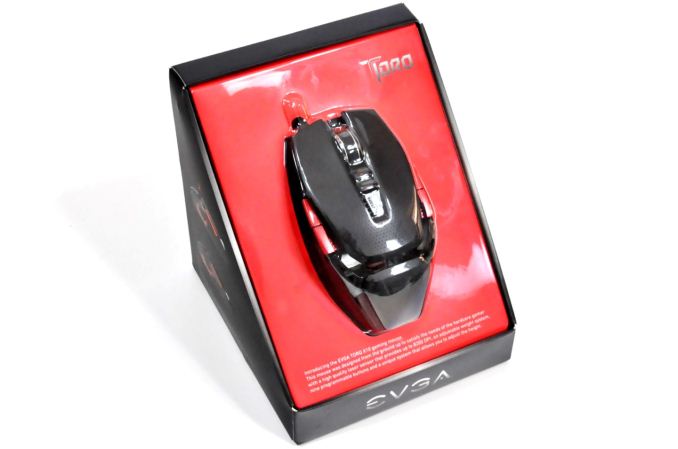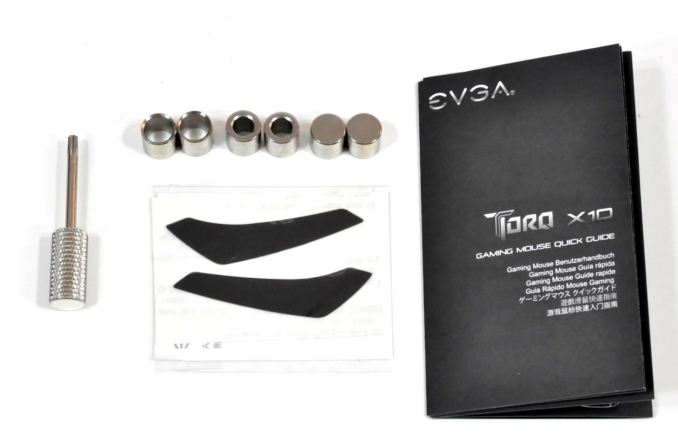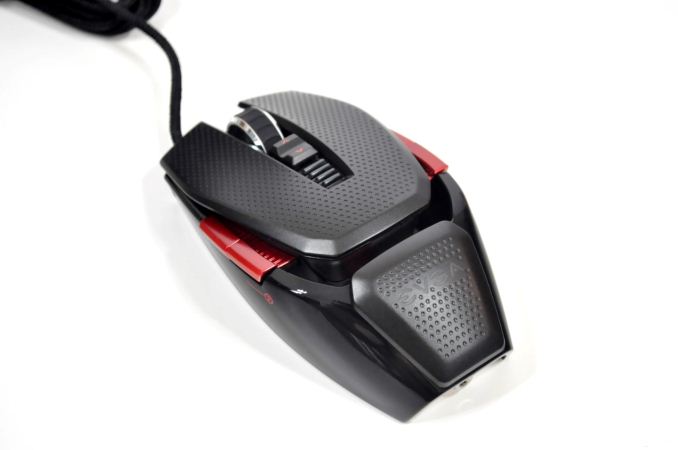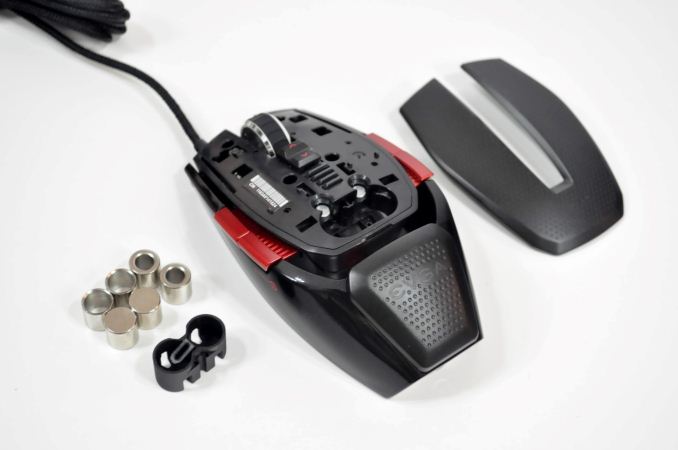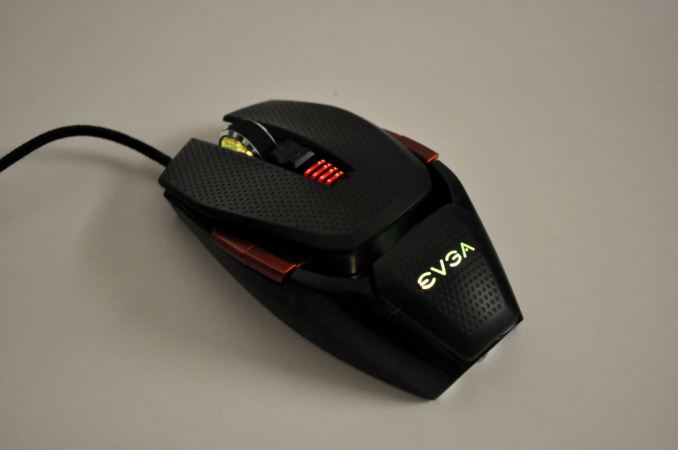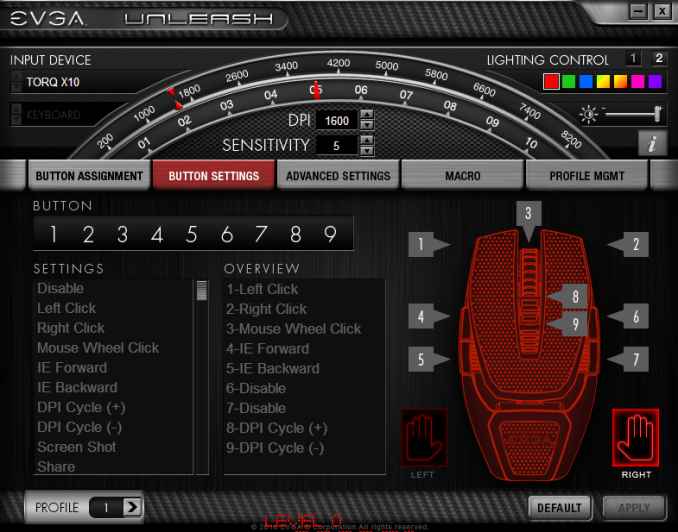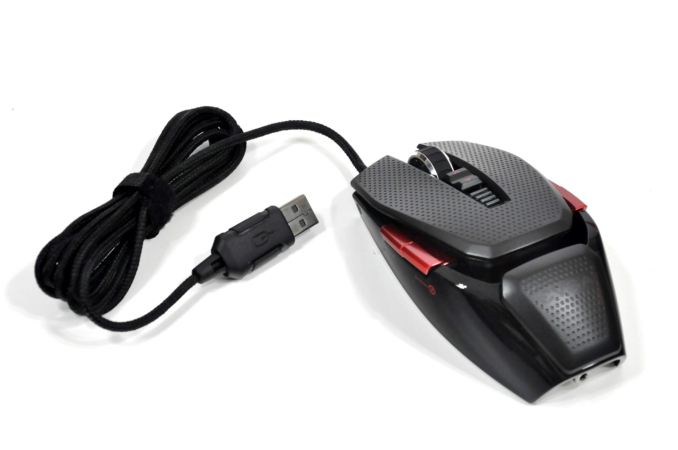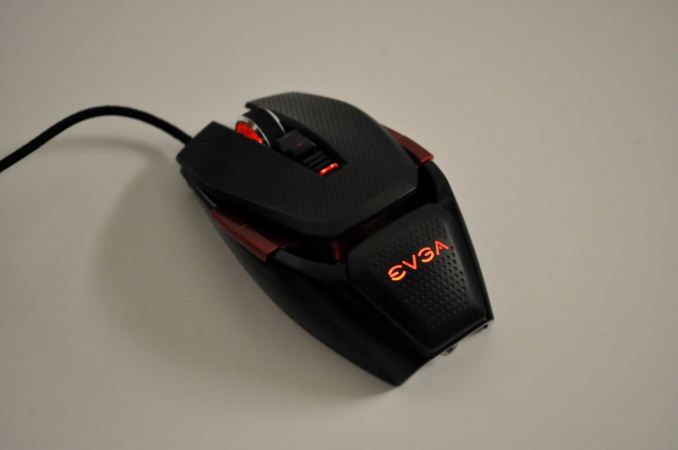
Original Link: https://www.anandtech.com/show/8393/evga-torq-x10-gaming-mouse-review
EVGA Torq X10 Gaming Mouse Review
by E. Fylladitakis on August 18, 2014 10:14 AM EST- Posted in
- Peripherals
- EVGA
- Mouse
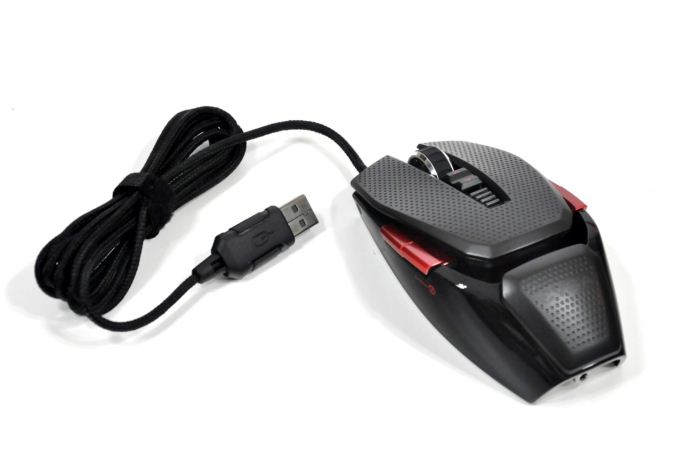
Introduction
It is natural for any growing company to look for diversification. For EVGA, a company known for their high quality GPU cards and gaming motherboards, growth has led them to seek further attention from gamers. The company already released several high performance PSUs and a few cases when their first gaming peripheral, the Torq X10 gaming mouse, arrived at our labs. We will be taking a quick look at it and see what it can offer to gamers and advanced users in today's capsule review.
Key features and specifications
- Max DPI: 8200
- Sensor Type: Laser (Avago 9800)
- Main Switch Type: Omron - 20 Million Click Lifecycle
- Programmable Buttons: 9
- Min/Max Weight: 121G/134G (without cable)
- Max Polling/Report Rate: 1000Hz
- LED Color: Red, Green, Blue, Yellow, Orange, Pink, Purple
- Feet Type: Low Friction PTFE
- Max Number of Profiles: 5 (512K Onboard)
- Height: 1.25in - 31.75mm (min) 1.5in - 38.1mm (max)
- Length: 4.5in - 114.3mm
- Width: 2.25in - 57.15mm
The specifications are good, though naturally there's more to a mouse than paper specifications. The Torq X10 includes programmable buttons, adjustable weight, profile and macro support, and adjustable DPI sensor.
- Onboard storage can support up to 5 separate profiles
- Ambidextrous design supports right or left handed gamers
- Adjustable height system supports all gamers
- Adjustable DPI up to 8200 DPI with On-the-Fly Sensitivity adjustment
- Adjustable weight system
- Highest quality materials including silver coated wire and Omron switches (20 million click life cycle)
- Robust software allows full control over mouse including Macro setup, profiles and OSD
- Super low friction PTFE mouse feet
Packaging and bundle
We received the EVGA Torq X10 in a well-designed, wedge-shaped package. The mouse can be clearly seen beneath the clear top of the package, which envelops the mouse and allows for a rough hands-on experience when browsing at a local shop.
Inside the box, we found six cylindrical weights, Teflon feet, an adjustment tool, and a very basic quick-start guide. There is no media with the drivers/software of the mouse; the user will have to download it from EVGA's website. Furthermore, do not fear if you accidentally lose the tool; it is a simple Torx T10 screwdriver that can be easily found at most tool shops or online. Ostensibly, the Torx T10 screw is what gave this mouse its name.
The EVGA Torq X10 Mouse
At this point, we should note that there are two versions of the Torq X10 mouse, the standard version and the carbon fiber one. The only difference between the two models is that the former uses standard plastic body materials, while the latter has some of them replaced with carbon fiber. The one depicted in this review is the standard version.
The Torq X10 is a symmetric, ambidextrous mouse with dotted matte top surfaces and glossy black sides. Each side sports two large red buttons that are strangely marked as "1" and "2" on either side of the mouse. It also has a large, ribbed scroll wheel, right above the DPI adjustment buttons. The Torx screw that adjusts the height of the mouse can be seen at the front, under the plastic body. By removing the top cover of the mouse, the user can insert the weights. Note however that only two out of the six provided weights can be inserted, limiting the maximum weight increase to a measly 12 gr (2 x 6 gr).
As far as quality is concerned, our feelings are mixed. We found very high quality Omron switches beneath the two main buttons, but that is not true for the side buttons, which feel a little mushy and wobbly. Although the body of the mouse is plastic, the frame is metallic, providing increased mechanical cohesion and ruggedness. The glossy sides of the Torq X10 however are somewhat slippery and give the mouse a cheap feel. This is probably not the case with the carbon fiber version, but shelling out $30 extra just for the feel of a mouse is not particularly cost-effective.
Beneath the mouse, we found one button and the Avago 9800 laser sensor. This button's default action is profile selection, making EVGA's choice of placement a double-edged knife; you will certainly not accidentally click it while gaming but you cannot change profiles on the fly either.
Performance
Working and gaming with the EVGA Torq X10 mouse has been a mixed experience. In terms of performance, the Torq X10 performed admirably on any surface that we tested it on. The Teflon feet are especially useful, making the mouse extremely easy to glide even on rough wooden surfaces. When we disabled all software acceleration, we could not spot any native acceleration coming from the laser sensor.
If there is one performance-related issue that we could complain about, it probably is the cycling DPI settings. If you are at the lowest DPI setting and click the DPI-down button, the mouse will go to the highest DPI setting and vice-versa. This is of critical importance in heavy action games, where DPI changes are almost certainly going to be made hectically and carelessly. While this is a concern, our major complaints with the EVGA Torq X10 mouse are regarding its ergonomics.
Even at its lowest possible height, the Torq X10 is a very large mouse and it is fairly difficult to grasp it comfortably, especially if you are used to non-symmetric ergonomic designs or if you have small hands. With my small to medium sized hands, the Torq X10 felt excessively large and bulky, even though I am used to working with large mice, such as the Logitech G602, on a daily basis. The placement of the side buttons feels off as well and will require at least a short learning curve before you can use them effectively.
There may be users that will like the size of the Torq X10, and tastes in mice are somewhat subjective, but there are also going to be users that simply find the X10 to be uncomfortable. Our advice is as usual that you should try this mouse in person before making a purchase.
The Software
The EVGA Unleash software that can be used to program the Torq X10 is easy to use and very well designed. There are two arched sliders at the top, one for the DPI level and one for the mouse sensitivity. For those that prefer a more straightforward input, there are also two numeric input boxes under the sliders. These will affect the DPI level and sensitivity of the current DPI setting, and the DPI can be set from just 200 DPI up to 8200 DPI.
Next to the sliders are the lighting controls, which allow the user to select from seven colors and adjust their intensity. Although there are only seven colors for the user to select from, we do not find this to be a drawback, even when compared to products that claim to offer millions of colors. Besides, once you realize how hideous every color other than red looks on the Torq X10, it is extremely unlikely that you will be switching the lighting color at all, even if only to recognize the set profile.
As for the buttons, the software allows for the complete repositioning and reprogramming of the buttons. You can switch between right hand and left hand mode by clicking a single icon and you can reposition or repurpose any button you want, even the main buttons. If you desire, you can set all side buttons to perform a single action, or disable any button entirely. As for the programmable actions, you can program the buttons to perform virtually any possible action, ranging from simple clicks and macro commands to screenshot captures and "rapid-firing" modes.
In the advanced settings tab, the user may adjust the DPI settings in detail. The first thing that can be adjusted is the number of DPI levels, ranging from just one and up to a maximum of five levels. It is also interesting that the DPI setting may be adjusted independently for each of the two movement axis. The polling rate of each DPI level may also be adjusted, although we do not really see the point with a wired mouse such as this. EVGA also added adjustments for the OS settings, including angle snapping and software acceleration. These settings are best left untouched for most people but advanced gamers will most likely want to disable them.
The macro programming and management capabilities of the software are quite good, although not iconic. It is possible to program any keystroke macro, as well as edit the time intervals. The recorder will recognize any mouse and or keyboard key pressed. However, it does not record the movements of the mouse, which is critical to perform advanced actions while gaming. Yes, you can cast several spells almost instantaneously, but you will not be able to open your inventory, swap gear and close it again in less than half a second. You will need a third-party macro recorder for that and, if it supports the compiling of .EXE files, you can then set the mouse button to launch the compiled application.
The Unleash software does support the export and import of macros to and from files, as well as the export and import of the entire profile. For those that like to share macros and other settings, this is a useful feature.
Conclusion
We feel that the strongest positive points of the Torq X10 are its great performance and solid software. There is a reason the Avago 9800 laser sensor is widely used by gaming mice designers and manufacturers. It has excellent tracking performance even at DPI settings so high that they're virtually unusable, on nearly every surface available, with nearly zero (practically immeasurable) hardware acceleration. Paired with a good controller and solid software, this sensor is excellent for gaming.
The presence of such a controller and software also allows for the thorough customization of the mouse, allowing it to be fashioned to fit the exact needs of each user. As far as performance and customization are concerned, the EVGA Torq X10 left us no room for any serious complains. But while the Torq X10 performs very well, we have mixed feelings about its overall quality.
The quailty of the Torq X10 is not bad, not even mediocre, but this is supposed to be a top-tier gaming mouse and so we cannot be forgiving. Mechanically, the Torq X10 is very well made, with a solid chassis and good plastic body parts. It also features a very good scroll wheel and Omron primary switches. On the other hand, the glossy plastics are slippery and get dirty very easily.
Furthermore, the side buttons feel wobbly and their high location is far from ideal, as it makes it both difficult for your thumb to adjust and easy to accidentally press them with your ring or pinky fingers. With some practice, an advanced user can achieve the ability to press the two side buttons with his or her thumb and the other two side buttons with the ring/pinky fingers, but that would require a significant amount of practice, and the odd grip would tire out the user quickly.
The location of the side buttons is not the only complaint we can make about the ergonomics of this mouse. Even at its lowest possible setting, the Torq X10 feels excessively long and a user with small hands would be barely able to use the wheel. Having short fingers does not help either, as the force required to press either of the primary buttons increases dramatically as you move away from the front of the mouse, meaning that the high force would certainly tire the user in no time at all. It is doubtful that this mouse would be usable by people with very small hands at all, especially children.
And then we come to the cost. EVGA's suggested retail pricing is at $90 for the normal model and $130 for the carbon fiber model. Thankfully, retail pricing is considerably lower, with the standard model available for $70 while the carbon fiber version is $100. These prices are still quite high, but they're at least more palatable than the MSRP. It's also hard to justify the >30% price increase just for a layer of carbon fiber on the sides of the mouse, but aesthetics are a subjective matter and there may be users willing to pay the premium.
As the first gaming mouse from EVGA, we had high expectations. Perhaps we are being a little too strict for the same reason. Regardless of its shortcomings, the Torq X10 still remains an excellent all-around performer. However, pragmatism suggests that EVGA will be facing very strong competition, even with the discounted retail prices that we mentioned. There are literally dozens of gaming mice available as direct competitors to the Torq X10, and some priced quite a bit lower. For example, there's the $80 Logitech G502 Proteus Core, $50 Corsair Vengeance M65, and $70 Mad Catz R.A.T. 7, to name just a few examples. With its retail pricing at $70, we believe that the Torq X10 has a fighting chance in today's retail market, especially among ambidextrous and left-handed users, but $90 or $130 would be far too much.

